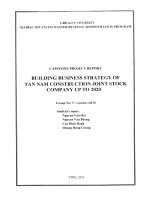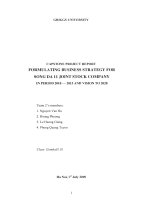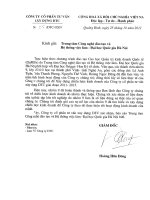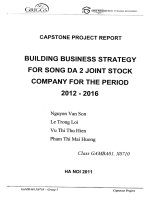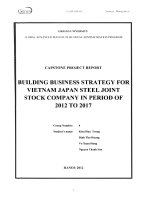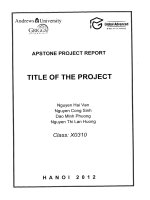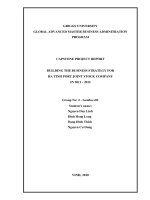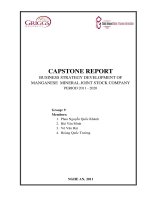Building the business strategy for Ha Tinh port joint stock company in 2011 - 2015
Bạn đang xem bản rút gọn của tài liệu. Xem và tải ngay bản đầy đủ của tài liệu tại đây (813.17 KB, 64 trang )
GRIGGS UNIVERSITY
GLOBAL ADVANCED MASTER BUSINESS ADMINITRATION
PROGRAM
CAPSTONE PROJECT REPORT
BUILDING THE BUSINESS STRATEGY FOR
HA TINH PORT JOINT STOCK COMPANY
IN 2011 - 2015
Group No: 2 - Gemba.v02
Student’s name:
Nguyen Duy Linh
Dinh Hong Long
Dang Dinh Thich
Nguyen Cu Dung
VINH, 2010
TABLE OF CONTENT
LIST OF ABBREVIATION i
LIST OF TABLES ii
ACKNOWLEDGMENT iv
LETTER TO HA TINH PORT JOINT STOCK COMPANY v
FEEDBACK FROM HA TINH PORT JOINT STOCK COMPANY vi
INTRODUCTION 1
1. Necessity of the Research 1
2. Research Object and Research Purpose 2
3. Research Scope 2
4. Research Methodology 3
5. Structure of the Capstone Project Report 3
CHAPTER I 4
THEORATICAL FUNDAMENTALS OF BUSINESS STRATEGY 4
1. Definition of business strategy 4
2. Roles of a business strategy for the performance and development of a
business 5
3. The Strategic Selection Process 6
Figure 1: Strategy Selection Process 6
4. Roles of Strategic Management Process 7
5. Strategy Classification 8
5.1. Corporate strategy 8
5.2. Business Unit strategy (SBU) 8
5.3. Functional strategy 8
6. Basic competition strategy 8
6.1. Cost Leadership Strategy 9
6.2. Differentiation strategy 9
6.3. Focused strategy 9
Figure 2: Basic Competitive Strategies 10
7. Business Environment Analysis 10
7.1. Macro Environment 11
7.2. Industry Environment 12
7.3. Analyzing Internal Business Environment 14
8. SWOT Analysis 14
9. Selecting Strategy by Quantitative Strategic Planning Method 15
CHAPTER II 17
ANALYSIS OF HA TINH PORT’S BUSINESS PERFORMANCE 17
1. Introduction to Ha Tinh Port Joint Stock Company 17
1.1. History 17
1.2. Business Activities 17
1.3. Organizational Structure 18
1.4. Human Resource 19
1.5. Infrastructure 19
1.6. Financial Capacity 19
2. Analysis of External Environment 20
2.1. Political and Legal Environment 20
2.2. Regional Economic Environment 20
2.3. Technological Environment 22
2.4. Natural Environment 23
2.5. Globalization Environment 23
2.6. Demographic Environment 24
3. Analysis of Industry Environment 24
3.1. Bargaining Power of Customers 24
3.2. Bargaining Power of Suppliers 25
3.3. Rivalry 25
3.4. Threat of New Entrants 27
3.5. Threat from Substitutes Products and Services 28
4. Analysis of Ha Tinh Port’s Business Performance in 2008-2010 28
4.1. Analysis of Current Business Strategy 28
4.2. Sales and Income 29
4.3. Main Customers 31
4.4. Main Competitors 32
4.5. Financial Ratios 32
5. SWOT Analysis 33
5.1. Strengths 33
5.2. Weaknesses 34
5.3. Opportunities 34
5.4. Threats 34
CHAPTER III 36
BUILDING COMPETITIVE STRATEGY FOR HA TINH PORT IN 2010-
2015 AND SUGGESTED EXECUTION SOLUTIONS 36
1. Strategy Selection 36
2. Strategy Formation 38
2.1. Vision 38
2.2. Mission 38
2.3. Objectives 39
2.4. Targeted Customers and Respective Service Offerings 39
2.5. Business Philosophy 39
2.6. Key Competitive Advantages in Focus Strategy 40
3. Suggested Functional Strategies and Execution Solutions 41
3.1. Execution of Marketing Strategy 42
3.2. Execution of Product and Service Development Strategy 45
3.3. Execution of Infrastructure Development Strategy 46
3.4. Execution of Human Resource Development Strategy 46
3.5. Execution of Finance Strategy 47
4. Suggested Execution Plan for Focus Strategy 48
RECOMMEND 50
CONCLUSION 52
REFERENCES 53
i
LIST OF ABBREVIATION
Abbreviation
Explanation
HTP
Ha Tinh Port Joint Stock Company
SWOT
Strengths ,Weaknesses, Opportunities and Threats
PEST
Political, Economic, Social, and Technological factors
Lao PDR
People Democracy Republic of Lao
DWT
Deadweight tonnage
ODA
Official Development Assistance
CPI
Comsumer price index
ISO
International Organization for Standardization
EFE
External Factor Evaluation
WTO
World trade Organization
IFE
Internal Factor Evaluation
FS
Financials Strengths
CA
Competitive Advantage
ES
Enviroment Stability
IS
Internals Strenghts
ii
LIST OF TABLES
Table 1: Port System in North Central of Vietnam 27
Table 2: Performance of Seaports in North Central of Vietnam 27
Table 3: Income Statement of Ha Tinh Port 29
Table 4: Revenue Structure of Ha Tinh Port since 2008 30
Table 5: Cargo through Vung Ang port 31
Table 6: Financial Ratios of Ha Tinh Port 32
Table 7: Balance Sheet of Ha Tinh Port at 31 Dec. 2009 33
Table 8: Application of QSPM in case of Ha Tinh Port 36
Table 9: SWOT Matrix of Ha Tinh Port 41
Table 10: Execution Plan for Focus Strategy 48
iii
LIST OF FIGURES
Figure 1: Strategy Selection Process 6
Figure 2: Basic Competitive Strategies 10
Figure 3: Five Force Model 12
Figure 4: SWOT Matrix 15
Figure 5: Organizational Structure of Ha Tinh Port 18
iv
ACKNOWLEDGMENT
Dear Lecturers and Professors of GAMBA program,
Dear the Director of Ha Tinh Port Joint Stock Company;
This capstone project titled “Building Business Strategy for the Ha Tinh Port
Joint Stock Company in 2011 -2015” is prepared by the Group 2 based on the
knowledge collected from the GAMBA program and other business data from Ha
Tinh Port Joint Stock Company.
We would like to thank lecturers and staff of Global Advanced Master
Business Administration Program, especially Associate Professor, Dr. Nguyen Thi
Tuyet Mai, Associate Professor, Dr. Ngo Kim Thanh, MBA. Pham Ngoc Thang,
MBA. Doan Hong Quan, Ms. Nguyen Thi Ha Giang and others who provided the
group with invaluable assistance and supports which enable the completion of this
capstone project.
We also would like to express our warm gratitude to Mr. Nguyen The
Cuong, Director of Ha Tinh Port Joint Stock Company and other managers who had
no hesitation to provide us with relevant information, data and even organized the
field visit to help us fulfill the project.
Due to limited time, there would be some inevitable shortcomings in the
making of this project. We look forwards to receiving constructive comments from
faculty of Griggs’s MBA program, Hanoi National University and especially from
the Board of Directors of Ha Tinh Port to further develop this project and increase
its applicability in the strategic management process of the Company.
Thank you very much indeed!
v
LETTER TO HA TINH PORT JOINT STOCK COMPANY
Dear Board of Directors, Ha Tinh Port Joint Stock Company.
We have taken the Global Advanced Master Business Administration
Program jointly organized by the Griggs University in the US and the Hanoi
National University.
To fulfill the Master Program, we need to complete a capstone project in
form of four member group. We are from the group No 2 out of 12 groups in
GaMBA V02 class.
The four members of the group are working in four different organizations in
Ha Tinh province. We would like to carry out a project which contributes to the
development of local businesses. We have learnt that the Ha Tinh Port Joint Stock
Company is facing big opportunities and challenges and has received strong
attention from the local and central governments. Particularly, a member of the
group is working for this company. Therefore, we decided to get and analyze
information about the company to propose a sound business strategy for the
company.
Therefore, it would be highly appreciated if the Board of Directors could
approve and support as well as provide information and required data to help us
access to the company’s business.
We hope that our willing will get your attention and the findings from this
research will help the port formulate an applicable competitive strategy for its
sustainable development.
Thank you very much!
vi
FEEDBACK FROM HA TINH PORT JOINT STOCK COMPANY
Dear Evaluation Committee of the Global Advanced Master of Business
Administration Program, Griggs University.
Ha Tinh Port Joint Stock Company received the letter from the Group No 2
regarding the capstone project titled “Building Business Strategy for the Ha Tinh
Port Joint Stock Company in 2011 -2015” which relates to the business strategy of
the Company. We understand that this is an opportunity for the Group No 2 to
access to the sea port service business which is being received great attention from
the Government because this is one of the most important businesses in the
country’s master development plan: maritime and sea port economic sector.
Although limited time, but through the process of working with Group 2, we
find that the team members worked hard to explore, study and apply the theory and
the data reported by companies a reasonable level, set out the issues and the very
practical question for the company's activities in general and content of research
topics in particular.
We highly appreciate the comments of the Group No 2 on the operation
process and strategic management process of the company. The Board of Directors
will consider and apply flexibly the findings (strategy) proposed by the Group.
On behalf of the Board of Directors, I wish the Group No2 and the
GeMBA01.V02 a successful completion of the MBA Program and flexible
application of the knowledge delivered by the courses that will help their companies
produce appropriate strategies for further development.
Wish the Global Advanced Master of Business Administration Program, the
Griggs University be successful with effective programs.
ON BEHALF OF HA TINH PORT JOINT STOCK COMPANY
DIRECTOR
Duong The Cuong
Global advanced Master of Business Administration
Business strategy for Ha Tinh Port
Group No.2 - Class GeMBA01.V02
1
INTRODUCTION
1. Necessity of the Research
The history of sea transportation in the world has shown that the maritime
economy is always considered the key sector with the leading role of the port. In
many parts of the world, the existence of the port has leaded the formation of urban
area together with the development of industry, economy and trade…etc. The more
the port is developed, the stronger the industry sector and economy in the area and
neighborhood are.
The Resolution No IV of Central Committee 10th on sea development
strategy of Vietnam to 2020 identified that “Vietnam must have a strong maritime
economy, seek prosperity from the sea, make the best use of all sea potentials as
well as developing all maritime related businesses with diversified modern structure
to speed up the development under a prompt, sustainable and effective manner in
the long –term perspectives.”
The Prime Minister issued the Decision No 2190/QD-TTg dated 24
December 2009 on the approval of Vietnam port system development planning up
to 2020 and the orientation to 2030. The main objectives of the planning are to
systemize the ports according to the master plan to meet the requirements of
industrialization, modernization as well as facility development to make Vietnam
ready in the integration process and able to compete in seaport business with other
countries in the region and in the world. Furthermore, this will help Vietnam
maintain its position and advantages in maritime economy development, at the same
time to protect the national security. The port system development also helps
connect Vietnam with important economic zones in the world to create dynamic
growth momentum for development of coastal urban and economic zones areas.
Ha Tinh Port Joint Stock Company is converted from a State owned
enterprise to the Joint Stock Company according to the Decision No 2668/QD
UBDN dated 24/09/2008 issued by Ha Tinh People’s Committee on the approval
Global advanced Master of Business Administration
Business strategy for Ha Tinh Port
Group No.2 - Class GeMBA01.V02
2
for shifting the Ha Tinh port under the Ha Tinh Trading and Mineral Co-operation
to the joint stock company. The Company’s business license No 2803000598 was
issued on 05/02/2009 by Vung Ang Economic Zone Management Unit. The main
functions of the company are to explore and do business on the seaport including
Vung Ang port located in Ky Loi commune, Ky Anh district, Ha Tinh province.
In recent years, although there have been still a lot of difficulties the Board
of Directors and staff have made big efforts in exploiting the strong points of the
port to improve its position in Vietnam Port System Map and in the South East Asia
region.
Given that it is the contact port of the Central North according to the
Government’s planning, Ha Tinh port has special tasks to the continued
development of Vung Ang economic zone and it will soon become a key national
port in the central region.
After many meetings and discussion with the company’s leaders, we get
exited with its vital importance and great growth potentials so we decided to select
the topic “Building the business strategy for the Ha Tinh Port Joint Stock
Company in 2011-2015” for our capstone project. We do hope that our efforts and
knowledge will bring the most practical and useful information to the company’s
leaders during the implementation process of its tasks and objectives.
2. Research Object and Research Purpose
Research objects: business operation and the current business strategy of the
Ha Tinh Port Joint Stock Company.
Research purpose: Analyze the characteristics of the port, commodity
market in the area, study and analyze the internal and external factors, using SWOT
model to analyze the company and its competitors to come up with appropriate
business strategy for the company from now to 2015. At the same time, solutions
and the action plan are proposed to carry out the strategy, contributing to the
development of the company from now to 2015.
3. Research Scope
Global advanced Master of Business Administration
Business strategy for Ha Tinh Port
Group No.2 - Class GeMBA01.V02
3
The research is carried out within the business management of Ha Tinh port,
based on information published in the public media including the situation and
trends of socio-economic development of Ha Tinh province, the central North
region, 2 provinces of People Democracy Republic of Laos: Khammuon and
Savanakhet and other provinces of Nongkhai, Sakhon Nakhon and Nakhon Phanom
in the Northern East of Thailand. Besides, the development planning of Vung Ang
economic zone, the Central North Region and the neighborhoods are also included
in our research. This helps us find out the most appropriate strategy for the
Company.
4. Research Methodology
This capstone project is done through a combination of different research
methods. It deploys various theories on strategy building such as PEST, 5
competitive forces, SWOT analysis and Quantitative Strategic Planning Method.
The research uses qualitative methods such as observation, interview, and
group discussion, comparison analysis to generate, analyze and summarize both
primary and secondary data on business activities of Ha Tinh port. Primary data will
be collected through interview and discussion with executives and other business
partners of Ha Tinh port as some important data or opinions are not publicly
revealed. The secondary data is gained in various reports from Ha Tinh port and
other publications.
5. Structure of the Capstone Project Report
Apart from the Table of Content, Introduction, Conclusion, Indexes,
References, the main content of the report includes three parts:
Chapter I: Theoretical fundamentals of business strategy
Chapter II: Analysis of Ha Tinh Port’s business performance
Chapter III: Selection of strategy for Ha Tinh Port and suggested execution
solutions
Global advanced Master of Business Administration
Business strategy for Ha Tinh Port
Group No.2 - Class GeMBA01.V02
4
CHAPTER I
THEORATICAL FUNDAMENTALS OF BUSINESS STRATEGY
1. Definition of business strategy
The term “strategy” is derived from the Greek word “strategos” which means
“general”. Under Alexander time, (330B.C), the term "strategy" came from military
activities, it shows the skills to use all forces and to create a totally dominant
position with the basic arguments that those who have these skills might defeat all
rivals, even though the rivals are more powerful by actively leading the game and
putting these opponents on the battlefield with advantageous settings for the best
performance of their capabilities.
According to Chandle (1962), strategy is the defining of long-term objectives
and purposes of the business, the acceptance of activity chain as well as allocating
its resources to achieve these objectives.
Quin (1980) shows that strategy is a pattern or an appropriate plan including
basic objectives, policies and chain of organization’s activities in a closed
comprehensive structure.
According to Fred David, strategy is a mean to achieve the long-term
objectives. The business strategy may include: territory expansion, diversified
operation, commodity ownership, product development, market penetration, cost
reduction and joint venture.
According to Michael Porter, strategy is to formulate an exclusive and
valuable position which creates the differentiation by making trade-off choice to
focus resources on achieving sustainable competitive advantages for the business.
According to William J. Glueck, strategy is a unified, comprehensive and
integrated plan designed to assure that the basic objective of the business are
achieved.
According to Johnson and Scholes, strategy is the direction and scope of an
organization over the long-term: which achieves advantage for the organization
Global advanced Master of Business Administration
Business strategy for Ha Tinh Port
Group No.2 - Class GeMBA01.V02
5
through its configuration of resources within a challenging environment, to meet the
needs of markets and to fulfill stakeholder expectations.
In conclusion, business strategy might be understood as the direction and
scope of the organization in the long term; the strategy will create the competitive
advantages for the organizations by optimally usage of resources in a competitive
environment to meet market demands and expectations of the shareholders. In other
words, strategy is the answers for the following questions:
- Where is the business trying to get to in the long-term? (direction)
- Which markets should a business compete in and what kinds of activities are
involved in such markets? (markets; scope)
- How can the business perform better than the competitors in those markets?
(advantage)
- What resources (skills, assets, finance, relationships, technical competence,
and facilities) are required in order to be able to compete? (resources)
- What external environmental factors affect the businesses' ability to
compete? (environment)
- What are the values and expectations of those who have power in and around
the business? (stakeholders)
2. Roles of a business strategy for the performance and development of a
business
The strategy could be understood as the well-rounded and comprehensive
plan of a business. The business strategy has important roles as the guideline for the
activity chain of the business to achieve objectives in the future, indicating the
following factors:
- Identify the long-term direction for a business, certifying the core objectives
of the business and where the business wants to get, what trends will the
business be developed, how will the business stay in the future market;
Global advanced Master of Business Administration
Business strategy for Ha Tinh Port
Group No.2 - Class GeMBA01.V02
6
- Focus the business’ efforts in implementing tasks, making best use of the
restricted resources, opportunities, mitigating the weak points and threats to
achieve the targets;
- Identify the organization and performance methods, formulating objectives
in the changing business environment according to multi orientation and
restricted resources;
- Establish the sustainability and harmonization of the business. Business
development must secure the sustainability and benefit harmonization. The
results of this development period will pave the way for the business to
further speed up in the future;
Building up a proper strategy will secure the success and sustainable
development for a business.
3. The Strategic Selection Process
The strategic selection is a process that defines clearly required activities,
arranging of researches to indicate the internal and external factors of a business,
formulating the long- term objectives as well as selecting the alternative strategies.
Strategic selection is the first phase of strategic management process. In strategic
management process, execution of strategic plan and evaluation of the progress will
be proceeded after selecting the strategy.
It’s very necessary to conduct the analysis and selection of a feasible
business strategy that requires the business to think of some solutions in order to
maximize the optimization. Selection of strategy is conducted after looking at the
SWOT matrix and applying strategy evaluation models to select the most
appropriate strategy for the business.
During the strategic selection process, it should clearly define the tasks of the
business which receive attention from the policy makers and the implementers.
Clear objectives are very important in formulating specific purposes as well as
strategic planning. The strategic selection process covers the following steps:
Figure 1: Strategy Selection Process
Global advanced Master of Business Administration
Business strategy for Ha Tinh Port
Group No.2 - Class GeMBA01.V02
7
4. Roles of Strategic Management Process
According to A.Chandler, strategic management is the process of defining
the long-term basic objectives of the business, selecting the methods or performance
direction as well as allocating required resources to implement these objectives.
Combina
tion of
models,
tools
Combina
tion of
models,
tools
Mission statement
and objectives
Analysis of the internal environment
(Identifying strong and weak points)
(S & W)
Analysis of the external environment
(identifying opportunities and threats)
(O & T)
Macro
environment
(PEST)
Sector environment
(five competitive
forces)
External factor
evaluation (EFE)
Internal Factor
Evaluation (IFE)
SWOT matrix
Business Strategy and
functional strategies
Combina
tion of
models,
tools
Global advanced Master of Business Administration
Business strategy for Ha Tinh Port
Group No.2 - Class GeMBA01.V02
8
Strategic management helps a business create a visionary perspective, setting
up core feasible objectives, building up successfully the strategy, conducting and
steering the strategy, and finally assessing and revising the strategy.
Most of the researches agree that if any business which knows how to
perform the strategic management well can reach their objectives compared with
those who do not have strategic management. The strategic management still helps
business deal with serious issues and improves the company’s ability in winning
opportunities when they come.
5. Strategy Classification
There are many types of strategy used for business and production process
but 3 types of strategy are found the most popular including:
5.1. Corporate strategy
Corporate strategy is concerned with the overall purpose and scope of the
business to meet stakeholder expectations. Corporate strategy tells companies which
markets or sectors to compete in. This is a crucial level since it is heavily influenced
by investors in the business and acts to guide strategic decision-making throughout
the business. Corporate strategy is often stated explicitly in a "mission statement".
5.2. Business Unit strategy (SBU)
Business Unit Strategy is concerned more with how a business competes
successfully in a particular market or sector. It concerns strategic decisions about
choice of products, meeting needs of customers, gaining advantages over
competitors, exploiting or creating new opportunities etc.
5.3. Functional strategy
The functional strategy is concerned with how each part of the business is
organized to deliver the corporate and business-unit level strategic direction. The
functional strategy focuses the issues of resources and specific implementation
tactics such as product strategy, pricing strategy, distribution strategy, market
penetration strategy, technology strategy …etc.
6. Basic competition strategy
Global advanced Master of Business Administration
Business strategy for Ha Tinh Port
Group No.2 - Class GeMBA01.V02
9
The competition strategy focuses on the potentials, strong points and weak
points of the company in the typical connection with markets and respective
potentials, strong and weak points of the competitors. According to M.Porter, there
are five basic competitive forces in every sector or industry. In order to be able to
cope up with these forces, businesses can build up their own strategies based on one
of three following directions:
- Cost leadership strategy
- Product differentiation strategy
- Focus strategy
6.1. Cost Leadership Strategy
In cost leadership, a firm sets out to produce same or similar product with
lower cost in its industry. The sources of cost advantage are varied and depend on
the structure of the industry. They may include the pursuit of economies of scale,
proprietary technology, preferential access to raw materials and other factors. A low
cost producer must find and exploit all sources of cost advantage. If a firm can
achieve and sustain overall cost leadership, then it will be an above average
performer in its industry, provided it can command prices at or near the industry
average.
6.2. Differentiation strategy
In a differentiation strategy a firm seeks to be unique in its industry along
some dimensions that are widely valued by buyers. It selects one or more attributes
that many buyers in an industry perceive as important, and uniquely positions it to
meet those needs. It is rewarded for its uniqueness with a premium price.
6.3. Focused strategy
The generic strategy of focus rests on the choice of a narrow competitive
scope within an industry. The focuser selects a segment or group of segments in the
industry and tailors its strategy to serving them to the exclusion of others.
The focus strategy has two variants.
Global advanced Master of Business Administration
Business strategy for Ha Tinh Port
Group No.2 - Class GeMBA01.V02
10
In cost focus a firm seeks a cost advantage in its target segment, while in
differentiation focus a firm seeks differentiation in its target segment. Both variants
of the focus strategy rest on differences between a focuser's target segment and
other segments in the industry. The target segments must either have buyers with
unusual needs or else the production and delivery system that best serves the target
segment must differ from that of other industry segments. Cost focus exploits
differences in cost behavior in some segments, while differentiation focus exploits
the special needs of buyers in certain segments.
Figure 2: Basic Competitive Strategies
7. Business Environment Analysis
All business activities can not be separated from the business environment.
Business environment factors have a tremendous impact on businesses because they
affect formulating and implementing strategy process directly. Analyzing business
environment is a process of examining, considering the different environmental
factors and identifying opportunities or threats to their businesses.
Business environment consists of macro environment and industry
environment.
Global advanced Master of Business Administration
Business strategy for Ha Tinh Port
Group No.2 - Class GeMBA01.V02
11
7.1. Macro Environment
Macro environmental factors include overall impact and operational
characteristics on that business. It is categorized into four factors: economic
conditions, political and social, cultural and natural population, technology, and
engineering. Each element of the macro-environment can affect the organization
independently or in association with other factors. Analyzing macro environment
helps businesses answer the question: what are businesses facing with? Macro
environment factors include:
7.1.1. Economic Environment
Four important factors macroeconomic environment include growth rate of
the economy, interest rates, exchange rates, and inflation rates.
7.1.2. Political- legal environment
Stability of the political and legal policies has great influence over the
enterprises activities creating opportunities or risks to the operation and
development.
7.1.3. Technology environment
Technology includes institutions, activities related to invention of new
knowledge and transferring that knowledge into the making of products, processes,
and materials. Technological changes include creation and destruction meaning
both opportunities and threats.
7.1.4. Cultural- social environment
It is related to social attitudes and cultural values. Cultural values and social
attitudes create social foundations leading to changes and technological conditions,
political-legal, economic and demographic conditions. Social changes also create
opportunities and threats for enterprises.
7.1.5. Natural environment
Geographical factors, regional characteristics, weather conditions, soil,
climate have an impact of business activities, bringing companies advantages or
Global advanced Master of Business Administration
Business strategy for Ha Tinh Port
Group No.2 - Class GeMBA01.V02
12
disadvantages, especially for those business, its activities depend on weather
conditions heavily.
7.1.6. Global environment
Global environment includes related global market, changing current market,
the internationally important political events and institutions characteristics and
background cultures in the global markets.
7.1.7. Demographic environment
Segmenting demography in the macro environment is related to population,
age structure, geographic distribution, ethnic communities, and distribution of
income
7.2. Industry Environment
Industry is a group of companies providing products or services that can closely
replace each other. Close alternative means that the products or services meet
basically similar customer needs. Industries are very different in economic
characteristics, competitive situations, prospects and future profitability. Economic
and current competitive conditions as well as projected future of the industry are a
basis to predict low, medium or high future profitability contributing sector
attractiveness.
Tasks of the strategic makers are to analyze and predict forces of competition
in the industry environment to identify opportunities and threats for enterprises
according to model of five competitive pressure presented by M. Porter.
According to M. Porter, there are five forces in competitive landscape within
a sector. Those are threats of new entrants, rivalry, bargaining power of buyers,
bargaining power of suppliers and the threat of substitute products. These five
forces affect business operations and profitability.
Figure 3: Five Force Model
Global advanced Master of Business Administration
Business strategy for Ha Tinh Port
Group No.2 - Class GeMBA01.V02
13
(Source: Five force – M.Porter)
7.2.1. Threats of New Entrants
Potential competitors include companies involved in new sectors. Their
current competitiveness is weak, but still has increasing potential in the future.
Potential competitors may reduce the profitability of their businesses due to the
exploitation of new production capacity, with the desire to win market share and
resources needed. Therefore, when formulating strategies administrators should
consider the risk due to join the rival branches of the new potential.
7.2.2. Competition within current industry
The second force in the competitive in the model of Michael Porter are
competitors already have solid gold position on the market in the same business.
There are three important factors constituting the level of competition among
companies operating in the same business. Those are structure competition;
situation-market demand; and the barrier out of the business sector. Important part
of controlling the external factors is to identify all the competitors and identify the
Combina
tion of
models,
tools
Threat of new entrants
Combina
tion of
models,
tools
Threat of substitute
products
Combina
tion of
models,
tools
Bargaining
power of
suppliers
Combina
tion of
models,
tools
Bargaining
power of
buyers
Competition within industry
Rivalry
Combina
tion of
models,
tools
Global advanced Master of Business Administration
Business strategy for Ha Tinh Port
Group No.2 - Class GeMBA01.V02
14
advantages, weaknesses, capabilities, opportunities, threats, objectives and
strategies of them.
7.2.3. Buyers
The third force in the Michael Porter’s 5 force model is the ability to
bargaining power of customers. Customers often request or require off-quality
goods to better come with excellent services. This makes the operating costs
increase the risk of creating price competition.
7.2.4. Suppliers
The fouth force is the ability of suppliers to bargain. Suppliers not only
supply materials, equipment and labor but also the service firms that provide
services such as consulting, advertising, shipping, and training. To avoid the
pressure of suppliers’ bargaining, company should build mutual benefit
relationships or have various choices of suppliers.
7.2.5. Substitutes
Substitute products are outside traditional boundary of current industry but
can satisfy same needs of customers. The price change of substitute products can
heavily affect the industry’s profitability if the customers’ price elasticity is high. A
closed substitute product will constrain the ability of firms in an industry to raise
price.
7.3. Analyzing Internal Business Environment
Analyzing internal business environment is to review and evaluate
characteristics of enterprise, the relationship between the departments figuring out
the strengths and weaknesses that company has to encounter, being premise for
utilizing, and promoting the strengths, limitations, overcome existing weaknesses.
Internal environment is composed of elements: human resources, finance,
technical facilities and technology, machinery and equipment. Analyzing internal
environment can approach from forming elements, or approach from the perspective
of the field, the functions of the business.
8. SWOT Analysis

